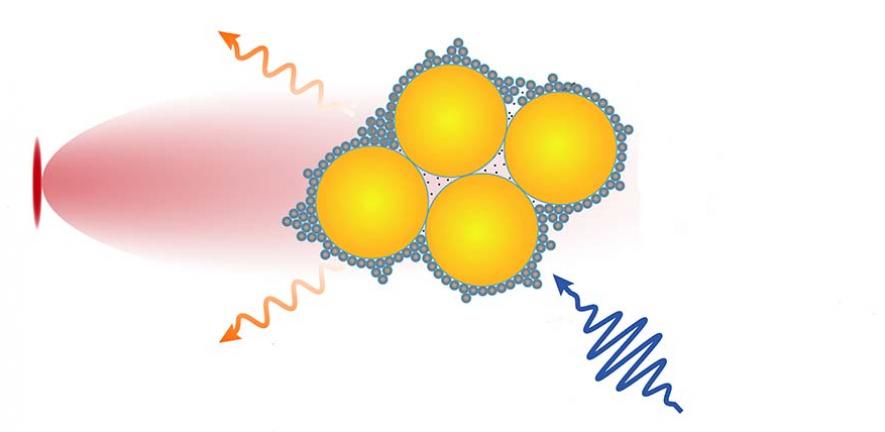(Nano ‘camera’ made using molecular glue allows real-time monitoring of chemical reactions)
2021-09-02 英国・ケンブリッジ大学

・ ケンブリッジ大学とユニバーシティー・カレッジ・ロンドン(ロンドン大学)が、リアルタイムで化学反応をモニタリングするナノスケールのカメラのように機能する、微細な半導体ナノ結晶デバイスの作製技術を開発。
・ 量子ドット、金ナノ粒子と分子糊であるククルビッドウリル(CB)を、調査対象の分子と共に室温下の水溶液中に配置すると、界面自己制御集合化(interfacial self-limiting aggregation)と称するプロセスにより数秒以内で効果的かつ安定したモニタリングツールへと自己組織化する。CB は、半導体量子ドットと金ナノ粒子の両者と強力に相互作用する。
・ これまでは、量子ドットの不在下で金ナノ粒子と分子糊を混合すると自己組織化の制御ができなかった。新作製技術では、半導体-金属ハイブリッド構造自体によるサイズと形状の制御を量子ドットが調節し、数週間安定性を維持するナノデバイス構造を構築する。あるナノ微粒子構造の組織化が、別のナノ粒子構造を加えることで制御可能であることを確認した。
・ 自然界は分子レベルで複雑な構造の構築を制御するが、研究室でそれを実施するには時間、コストと煩雑なプロセスを要する。多種類の化学種を組み合わせて優れた特性のハイブリッド材料を作製する作業は困難であり、無制御の成長や不安定な材料の生成に終わることが多い。新技術では、シンプルな設備を使用して複雑・高価な技術成果が獲得できる。
・ 同ナノデバイスは、半導体内で光を捕獲して光合成で起こるような電子輸送を誘発し、金ナノ粒子センサーと表面増強ラマン分光を通じてその様子をモニタリングする。今回、理論は確立されていたが直接的な観察がされていなかった化学種のリアルタイムモニタリングに成功した。
・ このようなプラットフォームは、光触媒や光起電力技術等の様々なアプリケーションに向けた多種類の分子に関する研究での利用が期待できる。
・ 現在、電子輸送プロセスをリアルタイムで直接観察可能な人工光合成システムと(光)触媒に向けたハイブリッド材料の開発に取り組んでいる。また、炭素-炭素結合の形成機構と電池アプリケーションに向けた電極界面について調査する。
・ 本研究には、英国・工学・物理科学研究評議会(EPSRC)が資金を提供した。
URL: https://www.cam.ac.uk/research/news/nano-camera-made-using-molecular-glue-allows-real-time-monitoring-of-chemical-reactions
<NEDO海外技術情報より>
(関連情報)
Nature Nanotechnology 掲載論文(アブストラクトのみ:全文は有料)
Nanoparticle surfactants for kinetically arrested photoactive assemblies to track light-induced
electron transfer
URL: https://www.nature.com/articles/s41565-021-00949-6
Abstract
Nature controls the assembly of complex architectures through self-limiting processes; however, few artificial strategies to mimic these processes have been reported to date. Here we demonstrate a system comprising two types of nanocrystal (NC), where the self-limiting assembly of one NC component controls the aggregation of the other. Our strategy uses semiconducting InP/ZnS core–shell NCs (3 nm) as effective assembly modulators and functional nanoparticle surfactants in cucurbit[n]uril-triggered aggregation of AuNCs (5–60 nm), allowing the rapid formation (within seconds) of colloidally stable hybrid aggregates. The resultant assemblies efficiently harvest light within the semiconductor substructures, inducing out-of-equilibrium electron transfer processes, which can now be simultaneously monitored through the incorporated surface-enhanced Raman spectroscopy–active plasmonic compartments. Spatial confinement of electron mediators (for example, methyl viologen (MV2+)) within the hybrids enables the direct observation of photogenerated radical species as well as molecular recognition in real time, providing experimental evidence for the formation of elusive σ–(MV+)2 dimeric species. This approach paves the way for widespread use of analogous hybrids for the long-term real-time tracking of interfacial charge transfer processes, such as the light-driven generation of radicals and catalysis with operando spectroscopies under irreversible conditions.



